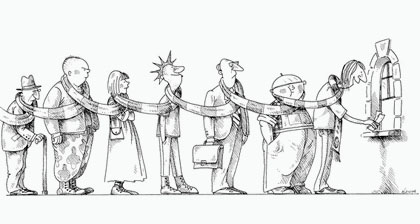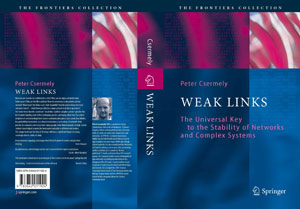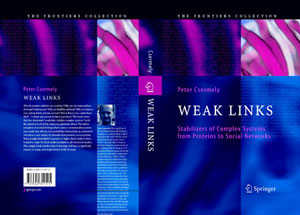Peter Csermely: Weak Links
Weak Links: The Universal Key to the Stability of Networks and Complex Systems Springer Verlag (Heidelberg, Germany) 2009.
You may find the google version of the book here
You may download the pdf chapters of the book from here.
To order directly from the publisher, download this form.
Stabilizers of Complex Systems from Proteins to Social Networks
Springer Verlag (Heidelberg, Germany) 2006
- from amazon.com
- from Barnes & Noble
- Canada
- UK
- Japan
- from Springer, or for orders from:
- Amazon.com
- Artificial Life 13: 207-208 (2007)
- Journal of Artificial Societies and Social Simulation
- Physics-web summary
- Planet Earth news
- Blog of Graham Durant-Law
"This is an excellent book, which shows the far-reaching consequences of the great variety of weak links. The book has a proper balance between a scientific monograph and a popular approach, and mixes humor with sharp intellect. "Weak Links" is an adventurous, entertainingly eclectic and rich work both for the experts and laymen."(László-Albert Barabási, Department of Physics, University of Notre Dame, author of the bestseller book, Linked and the 1999 seminal Science paper on the preferential attachment model of scale-free network topology.)
"You have written a very personal, engaging, and unique book that will appeal to readers and get them thinking." (Steve Strogatz, Dept. of Theoretical and Applied Mathematics, Cornell University, author of Sync and the 1998 seminal Nature paper on small worlds.)
"You have done a great service by making the world of networks understandable and clear. I will use your book in my classes." (Caroline S. Wagner, Center of International Science & Technology Policy, George Washington University, author of several science policy-related books including the an upcoming work on the international collaboration in science)
"This book links an exceptionally large number of areas and gives exciting novel information to both the network experts and the science-orinted general readership."(Tamás Vicsek, Dept. Biological Physics, Eötvös University, author of several network-related Nature papers including a method to determine overlapping network modules)
"This masterpiece should serve as an example how science can be discussed. Entertaining yet thought provoking." (György Buzsáki, Board of Governors Professor, Center for Molecular and Behavioral Neuroscience Rutgers University, a leading expert of neuronal networks)
"You have written a true gem of a book; erudite, humane, funny, accessible and thoroughly fascinating. On every page, I find another delight that makes me smile and leads me down new intellectual paths (weak links again!). Thanks to your thorough footnotes, I can delve as deep as I would like into the professional papers. Outstanding - I wish more books were written this way. I have adopted your book as a textbook for my Science of Networks class, and I will recommend it to anyone who ask without hesitation. You did a great service to pedagogy and to this budding science with this magisterial survey. I really appreciate it and my students will, as well." (Daniel J. Bilar, Computer Science Department, Wellesley College MA, USA)
"Stupendous and unusual; catches the excitement of network ideas, while boldly advancing the relevance of weak links as an important concept." (Jake Keenan, amazon.com)
"Thank you, and all the others (including Spite and Pity) who actively contributed to this amazingly helpful book." (David L. Hawthorne, Co-founder, Vice President, Affiliate Relations, NavAgility LLC, www.navagility.com)
"Brilliant book -- he summarizes research from many fields by using the perspective of weak links. The annotated bibliography might be worth the price of the book alone! Every few pages I put the book down and reflect on how it ties things together. If I only had 5 systems books this would be one. (Curt McNamara, amazon.com )"
- Preface
- A Principle is Born: The Granovetter Study
- Why Do We Like Networks?
- Small-Worldness
- Scale-Freeness
- Scale-Free Degree Distribution of Networks
- Underlying Reason for Scale-Freeness: Self-Organisation
- Scale-Free Distribution in Time: Probabilities
- Scale-Free Survival Strategies: Levy Flights
- Scale-Free Pleasures
- Nestedness
- Weak-Linkness
- Network Stability
- 3.1 Perturbations. Good and Bad Noise
- Life as a Relaxation Phenomenon: Dissipate Locally, Connect Globally
- Confined Relaxation with Global Connection
- Self-Organised Criticality
- Network Failures
- Topological Phase Transitions of Networks
- Nestedness and Stability: Sync
- How Can We Stabilize Networks? Engineers or Tinkerers
- Weak Links as Stabilizers of Complex Systems
- An Emerging Synthesis: Weak Links Stabilize Complex Systems
- Weak Links: A Starting Definition
- Stability: A Starting Definition
- Complex Systems
- Weak Links and System Degeneracy
- Atoms, Molecules and Macromolecules
- Protein Folding Problems
- Energy Landscapes
- Weak Bonds in Protein and RNA Folding
- Weak Links and Cellular Stability
- Cellular Networks
- Stability of the Cellular Net
- Stress, Diversity and Jumps in Evolution
- Cancer, Disease and Aging
- Cancer
- Disease
- Aging
- Weak Links and the Stability of Organisms
- Immunological Networks
- Transport Systems
- Muscle Net
- The Neuro-Glial Network
- Psycho Net
- Social Nets
- Animal Communities
- A Novel Explanation of the Menopause
- Stability of Human Societies
- Firms and Human Organisations
- Dark Networks and Terror Nets
- Pseudo-Grooming
- Networks of Human Culture
- The Language Net
- Novels, Plays, and Films as Networks
- Our Engineered Space
- Software Nets
- Engineers and Tinkerers: An Emerging Synthesis
- The Global Web
- The World Trade Web
- Turning Points in History
- Weak Links: A Part of Social Capital
- The Ecoweb
- Weak Links and the Stability of Ecosystems
- Omnivory
- The Weak Links of Gaia
- Conclusions and Perspectives
- The Unity of the Weakly-Linked World: A Summary
- Revisiting the Definitions: A Synthesis
- Prospects and Extensions
- Weak Links and Our Lives
Appendix
- Useful Links
- Glossary
- References
Édua Szűcs, the famous Hungarian artist agreed to make the illustrations for the book. She permitted to put one of them (illustrating weak links) here.

Translations
- To Hungarian: Vince Publishers, Budapest, Hungary, 2005

You may order the Hungarian translation at Vince Publishers' page
The pdf version of the chapters may be downloaded from here.
The Hungarian version was voted to be among the best 500 Hungarian books (best 250 non-fiction books) recommended to all Hungarian libraries.

Questions | Address | Design and maintenance | Visitors since 7th July 2004:



